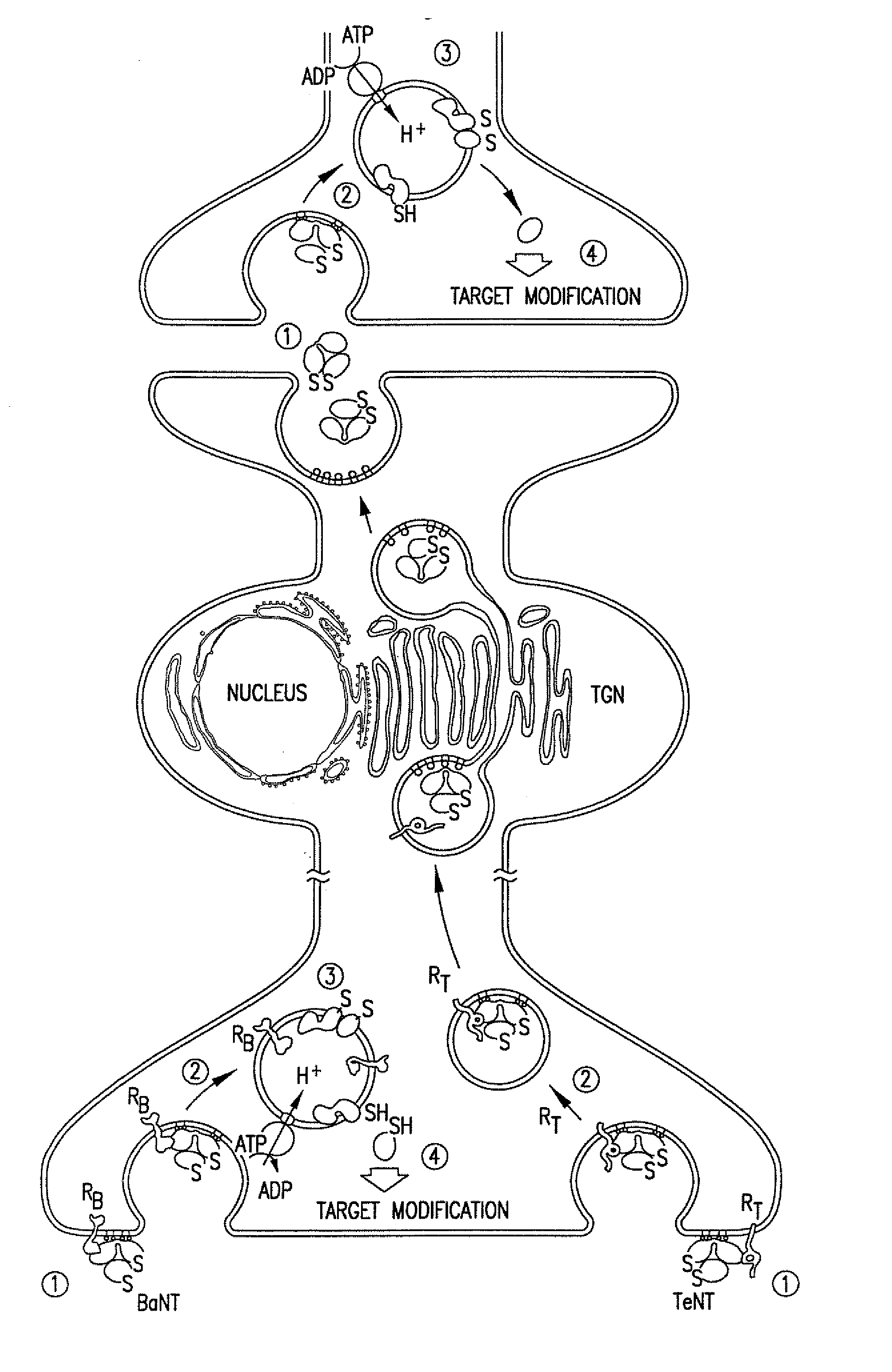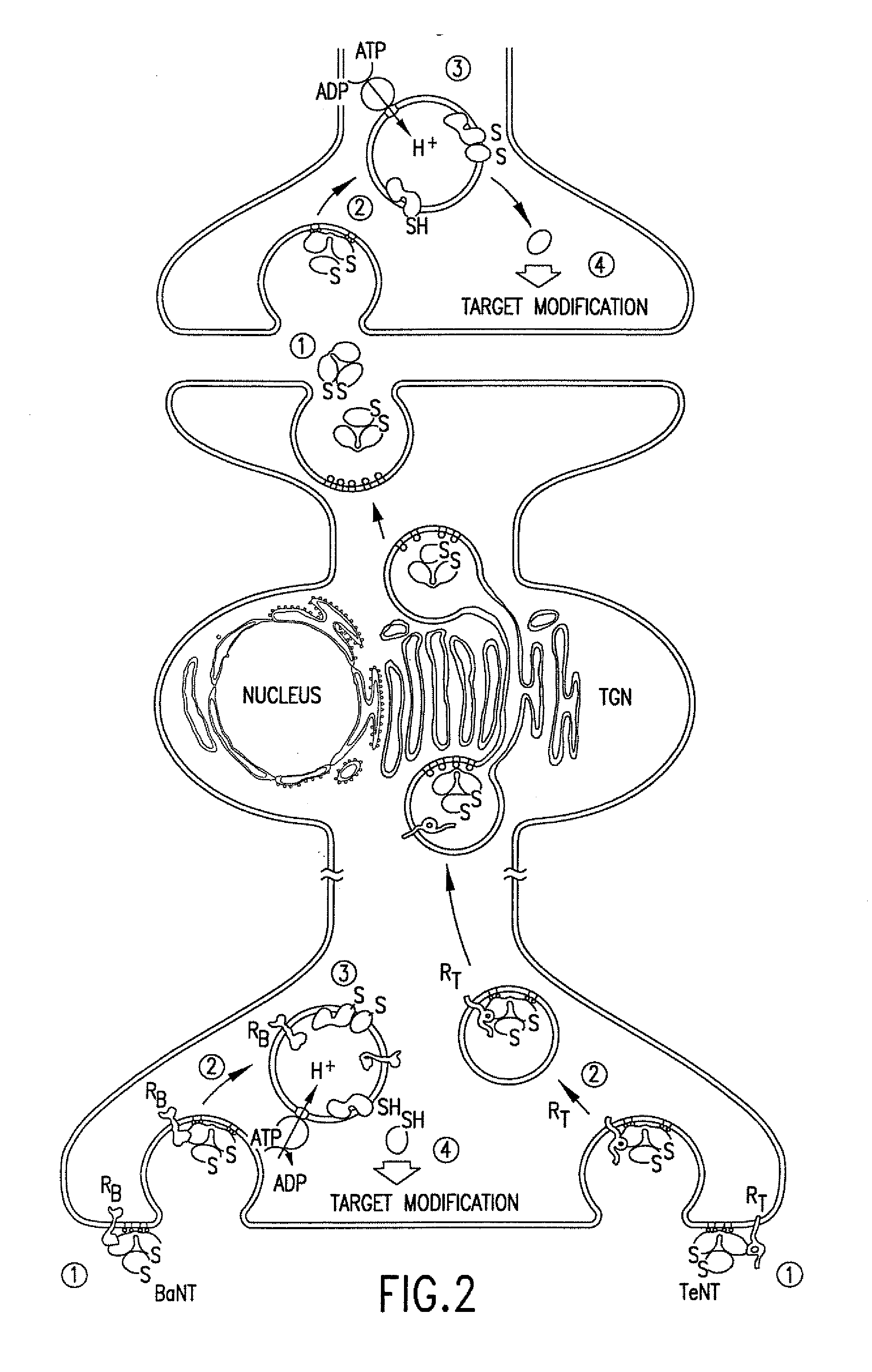[0025] A method of the invention can be used to assay the protease activity of any clostridial toxin. In one embodiment, a method of the invention relies on a BoNT / Asubstrate to determine BoNT / Aprotease activity. A BoNT / Asubstrate useful in a method of the invention can be any of the BoNT / Asubstrates disclosed herein, for example, a BoNT / Asubstrate containing at least six consecutive residues of SNAP-25, where the six consecutive residues include Gln-Arg. In another embodiment, a method of the invention relies on a BoNT / B substrate to determine BoNT / B protease activity. A BoNT / B substrate useful in a method of the invention can be any of the BoNT / B substrates disclosed herein, for example, a BoNT / B substrate containing at least six consecutive residues of VAMP, where the six consecutive residues include Gln-Phe. A method of the invention also can utilize a BoNT / C1 substrate to determine BoNT / C1 protease activity. A BoNT / C1 substrate useful in a method of the invention can be any of the BoNT / C1 substrates disclosed herein, for example, a BoNT / C1 substrate containing at least six consecutive residues of syntaxin, where the six consecutive residues include Lys-Ala, or containing at least six consecutive residues of SNAP-25, where the six consecutive residues include Arg-Ala.
[0026] In another embodiment, a method of the invention relies on a BoNT / D substrate to determine BoNT / D protease activity. A BoNT / D substrate useful in a method of the invention can be any of the BoNT / D substrates disclosed herein, for example, a BoNT / D substrate containing at least six consecutive residues of VAMP, where the six consecutive residues include Lys-Leu. In a further embodiment, a method of the invention relies on a BoNT / E substrate to determine BoNT / E protease activity. A BoNT / E substrate useful in a method of the invention can be any of the BoNT / E substrates disclosed herein, for example, a BoNT / E substrate containing at least six consecutive residues of SNAP-25, where the six consecutive residues include Arg-lle. In yet a further embodiment, a method of the invention relies on a BoNT / F substrate to determine BoNT / F protease activity. A BoNT / F substrate useful in a method of the invention can be any of the BoNT / F substrates disclosed herein, for example, a BoNT / F substrate containing at least six consecutive residues of VAMP, where the six consecutive residues include Gln-Lys.
[0027] A method of the invention also can utilize a BoNT / G substrate to determine BoNT / G protease activity. A BoNT / G substrate useful in a method of the invention can be any of the BoNT / G substrates disclosed herein, for example, a BoNT / G substrate containing at least six consecutive residues of VAMP, where the six consecutive residues include Ala-Ala. A method of the invention also can be useful to determine TeNT protease activity and, in this case, relies on a TeNT substrate. Any of the TeNT substrates disclosed herein can be useful in a method of the invention, for example, a TeNT substrate containing at least six consecutive residues of VAMP, where the six consecutive residues include Gln-Phe.
[0028] A variety of samples that potentially contain an active clostridial toxin, or light chain or fragment thereof, are useful in the methods of the invention. Such samples include, but are not limited to, crude cell lysates; isolated clostridial toxins; isolated clostridial toxin light chains; formulated clostridial toxin products, for example, BOTOX®; and foodstuffs, including raw, cooked, partially cooked or processed foods or beverages.
[0029] In a method of the invention, resonance energy transfer can be determined by a variety of means. In one embodiment, the step of determining resonance energy transfer includes detecting donor fluorescence intensity of the treated substrate, where increased donor fluorescence intensity of the treated substrate as compared to the control substrate is indicative of clostridial toxin protease activity. In another embodiment, the step of determining resonance energy transfer includes detecting acceptor fluorescence intensity of the treated substrate, where decreased acceptor fluorescence intensity of the treated substrate as compared to the control substrate is indicative of clostridial toxin protease activity. In a further embodiment, the step of determining resonance energy transfer includes detecting an acceptor emission maximum and a donor fluorophore emission maximum of the treated substrate, where a shift in emission maxima from near the acceptor emission maximum to near the donor fluorophore emission maximum is indicative of clostridial toxin protease activity. In an additional embodiment, the step of determining resonance energy transfer includes detecting the ratio of fluorescence amplitudes near an acceptor emission maximum to the fluorescence amplitudes near a donor fluorophore emission maximum, where a decreased ratio of the treated sample as compared to a control sample is indicative of clostridial toxin protease activity. In yet a further embodiment, the step of determining resonance energy transfer is practiced by detecting the excited state lifetime of the donor fluorophore, where an increased donor fluorophore excited state lifetime of the treated substrate as compared to the control substrate is indicative of clostridial toxin protease activity.
[0030] As discussed further below, a variety of conditions suitable for clostridial toxin protease activity are useful in a method of the invention. In one embodiment, the conditions suitable for clostridial toxin protease activity are selected such that the assay is linear. In another embodiment, conditions suitable for clostridial toxin protease activity are selected such that at least 90% of the clostridial toxin substrate is cleaved. In a further embodiments, conditions suitable for clostridial toxin protease activity are selected such that at most 5%, at most 10%, at most 15%, at most 20% or at most 25% of the clostridial toxin substrate is cleaved.
 Login to View More
Login to View More 


